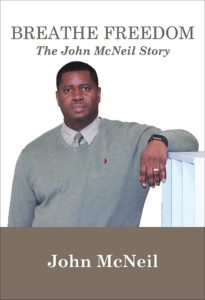
I sat listening to John McNeil answer audience questions about Breathe Freedom, his memoir of defending himself in a stand-your-ground state and his subsequent arrest, imprisonment, and release. As he offered one fascinating (or horrifying) story after another, I asked myself, Why didn’t he include that in his book? But I knew the answer already: Because it didn’t support the theme.
What you omit is as important as what you include.
While autobiography tends toward “here’s my entire life story,” memoir is more limited in scope. The author often reflects on a particular time or event or covers a longer time frame but adheres to a clear theme.
John takes the latter approach in Breathe Freedom. He tells the story of his arrest and incarceration, but he begins with his upbringing, with stories about basketball, parenthood, career accomplishments—all the things that shaped the man he is, led him to the critical turning point in his life, and allowed him to survive prison. He doesn’t tell us every childhood story or describe every brutal moment in prison, just enough to paint the thematic picture.
Deciding what to leave out applies to other forms of nonfiction besides memoir—business, self-help, thought leadership. In the end, the goal is the same: give your readers a cohesive, coherent narrative so they understand your message and know how to respond. To do that, you must be clear on what to keep and what to cut.
As I work with clients, I commonly suggest five practices to determine when or where to deploy the scalpel.
Develop guidelines that flag potential cuts.
Two major guidelines help identify candidates for excision: structure and word count.
Frequently, chapters in a nonfiction book have a similar structure. The step in the process, why it’s important, how to do it. Story, principle, example, call to action. Key concept, supporting material, example, conclusion. If you’ve defined your structure clearly enough, it becomes apparent when a chapter is too heavily weighted on one element, e.g., five examples when only three are needed. Not only can you check the balance within chapters, but you can look across chapters.
If you have a book with ten chapters and want to target 50k words total, you know your goal is roughly 5,000 words per chapter. If you exceed 5,000 words, that’s a clear indicator: Do you need to cut something? Maybe, maybe not—you may decide one chapter needs to be longer, and you can make cuts elsewhere in the book.
Pretend you must cut your writing in half.
When I edit, I can usually cut 10–20% of the text simply by tightening up the language without losing actual content. But imagine you must cut your book in half. At that point you almost certainly must cut content. But what content?
Identify what you think you will cut, then ask yourself: If you leave that content out, does your book end up weaker or stronger? If it’s weaker, identify and keep the critical elements. But you may be surprised to find that shorter can be stronger. I had a client who cut his book from 60k words to 35k words and it was better than stronger—it was tight. (Think hot jazz-trio tight.)
Assess every bit of content for relevance.
 Whether it’s a story, a piece of data, or other information, does your content link to the overarching thesis of the work? Does it support your core message? Even if something is interesting, it may not be relevant.
Whether it’s a story, a piece of data, or other information, does your content link to the overarching thesis of the work? Does it support your core message? Even if something is interesting, it may not be relevant.
For example, in John’s Q&A session, the stories he told about his prison experience were interesting for listeners with little understanding of how prison works, but they were not critical to the journey the book covered. They would be perfect, however, for a book on prison reform. If that were the book’s focus, John would add more prison stories and probably cut most of his childhood reminiscences.
Focus on your unique value.
Most of us have expertise we bring to the table or aspects of writing at which we excel. Leverage those specialties.
I have a client who has an extraordinary talent for storytelling. She’s brilliant at spinning yarns and evoking unfamiliar settings. But when she starts explaining theoretical concepts, her writing gets flabby and sags. In revision, she needs to look at those abstract portions of the text—can they be cut? Or could she use her gift for storytelling to illustrate the concepts and thus amp up reader interest?
Ask your beta readers.
Beta readers are those trusted friends and colleagues you ask for feedback on your nearly complete book. If you are concerned your book is too long, ask your readers to flag sections that drag or information they find extraneous.
But don’t make it your beta readers’ job to tell you what you already know—make sure you’ve honed your message as much as possible before sending them your manuscript. (Use the tips above!) And do be willing to listen to what they have to say.
But what about all the extra stuff?
It can be frustrating to have stories and information you want to include but end up cutting. Don’t worry. You can use those pieces in a presentation or Q&A like John did, in an article or blog post—or in your next book!
Need an assessment of your manuscript for wordiness or gaps? A manuscript critique and strategy intensive may be for you. Get in touch at karin@clearsightbooks.com or 919.609.2817.

